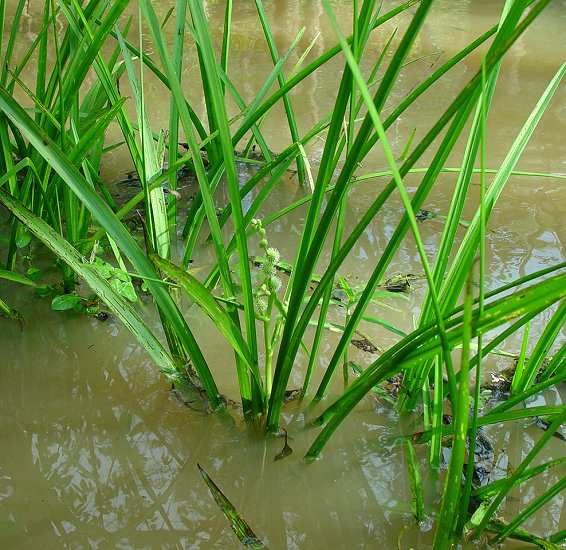Sparganium americanum Nutt.
Bur-Reed

Native
CC = 8
CW = -5
MOC = 34
© DETenaglia
Sparganium americanum Nutt.Bur-Reed | |
 |
Native CC = 8 CW = -5 MOC = 34 |
© DETenaglia |
|
Family - Sparganiaceae Habit - Rhizomatous monoecious perennial forb. Stems - Ascending to erect, to 1 m, simple or sometimes few-branched in the inflorescence. Leaves - alternate, 2-ranked, linear, the bases sheathing, the blades sometimes spongy-thickened, parallel-veined, to 100 cm long, 4-12 mm wide, thin, soft, flat to sometimes slightly keeled. Inflorescences - Dense heads, these alternate, usually subtended by leaflike bracts, sessile along the often flexuous upper stems, the staminate heads above the pistillate heads, the individual flowers tiny, with small bracts similar to the tepals.
Flowers - Staminate flowers with 1-6 oblong to spathulate, scalelike tepals and 1-8 stamens, the filaments sometimes united toward the base. Pistillate flowers with 3-6 linear to spathulate, scalelike tepals and 1 superior ovary with 1 or 2 locules. Styles 1 per carpel. Stigmas 1 per flower, 1-2 mm long.
Fruits - Fruiting heads 1.5-2.5 cm in diameter. Fruits drupelike with spongy layers surrounding the 1 seed, not shiny, the body 3-5 mm long, fusiform, broadest about the middle, narrowed to a stalklike base, the the style persisting as a beak 3.0-4.5 mm long.
Flowering - May - September. Habitat - Spring branches, streams, rivers, sloughs. Emergent or submerged aquatic. Origin - Native to the U.S. Lookalikes - Other species of Sparganium. Other info. - This species is characteristic of the spring branches and coldwater streams of the Ozarks, where it often occurs as sterile, submerged plants with the leaves horizontal in the current. It is otherwise found in scattered locations across the eastern half of the continental U.S., also ranging into Canada. Vegetatively it can resemble a number of other plants, but the inflorescences and macelike fruits are unique to the genus. Differentiation from the other two Missouri species relies on examination of the stigmas (one per flower in this species) and fruit and leaf morphology. Photographs taken in Brown Summit, NC., 7-15-02 (DETenaglia); also at Busch Wildlife Area, St. Charles County, MO, 7-20-2018 (SRTurner). |